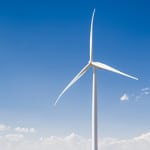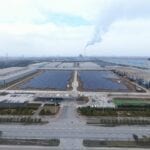China continues to finance new coal plants in more than two dozen countries, even as the country has taken the lead in global renewable energy investment, according to a report from a U.S. group of energy analysts.
The Institute for Energy Economics and Financial Analysis (IEEFA) in its report said China is backing more than a quarter of coal plants under development worldwide.
The report, “China at a Crossroads: Continued Support for Coal Power Erodes China’s Clean Energy Leadership,” detailed in a Jan. 22 news release from the IEEFA, looks at China’s financing of coal projects. The group says “funding coal plant projects leaves China and the 27 countries reliant on Chinese coal financing increasingly exposed to bad economic outcomes as nations move away from coal.”
“The International Energy Agency’s most conservative modeling forecasts declining global coal trade post-2018 for good reason,” said Melissa Brown, energy finance consultant for the IEEFA and one of the report’s co-authors. “Coal power locks importing countries into years of uncertainty about power prices as coal prices gyrate. By contrast, renewables are benefitting from huge technology improvements and have a deflationary impact on power prices.”
Brown continued: “Many private global financial leaders, including most multilateral development banks, have come to see thermal coal as a poor investment with growing stranded asset risks. The World Bank, Standard Chartered UK, Generali of Italy, and Nippon Life of Japan have all turned their back on coal power for solid financial reasons.
“China is making great progress towards becoming a world leader in renewable clean energy at home, but outdated logic about power system design continues to dominate China’s overseas finance habits. China’s leading financial institutions lag their global peers in formally limiting investment in coal plants in international markets, imposing stranded asset risks on countries that will struggle to adapt as coal power becomes obsolete.”
The IEEFA said China’s state-controlled banks and other financial groups have either committed to finance, or have formally offered funding, to about 102 GW of the 399 GW of coal-fired power generation under development outside the country. The group said that investment includes money directed toward rail and port infrastructure for coal plants, along with export coal mines.
More than $7 billion of financing is committed to projects in Bangladesh, representing about 14 GW of coal-fired generation capacity. Other countries with significant Chinese investment in coal plants include Vietnam, South Africa, Pakistan, and Indonesia.
Christine Shearer, another co-author of the report, said, “These countries and more are instilling both a long-term dependence on volatile fossil fuel imports, and a dependence on China through coal plant joint ownership and/or strategic arrangements plus excessive foreign financial leverage, precisely at the time when prices for solar, wind, and energy efficiency costs are falling below imported coal power.”
The report also noted that much of the financing of projects outside China includes stipulations that the plants be built with “a largely Chinese workforce.”
Investment in Renewables
China has taken the top spot in global investment in renewable energy, according to many energy analysts. The country is home to many of the world’s largest solar farms.
China last year increased its renewable portfolio standard to 35% of power consumption by 2030, and in recent years has slowed development of domestic coal-fired generation.
A report from the Global Commission on the Geopolitics of Energy Transformation, a group established by the International Renewable Energy Agency (IRENA) last year, released Jan. 11 at IRENA’s annual assembly in Abu Dhabi said, “No country has put itself in a better position to become the world’s renewable energy superpower than China.”
The report in part said the geopolitical and socio-economic consequences of growth in renewable energy could lead to new countries taking lead roles in global energy, with countries such as China gaining more power, while those dependent on oil and gas revenues, such as Russia and Saudi Arabia, see their influence wane.
Tim Buckley, another of the report’s authors, told POWER: “China is currently technology agnostic when it comes to outbound investment in the energy sector. China is the world’s largest developer of hydro, nuclear, renewables and coal, and recently the AIIB [Asian Infrastructure Investment Bank] started financing global gas power and pipeline infrastructure as well as its zero-emissions priority in renewables and grid. Domestically, China has given significant priority to developing zero-emissions industries of the future, and their efforts in grid transmission, smart meters, hydro, batteries, electric vehicles, wind and solar are world-leading, with a clear priority on rapidly shifting to lower pollution, lower emissions technologies. Energy security is also a key priority for China domestically, and diversity of technologies leveraging domestic re-occurring resources (hydro, wind, solar, energy efficiency) is a clear if largely unstated focus.”
Buckley continued: “Our report aims to highlight the divergence in China’s domestic versus outbound international investment priorities. We would attribute this largely to one of redeploying redundant capacity—managerial and engineering, plus finance. All Chinese firms have a growth focus. Coal or hydro companies in China have built up world-leading technologies, management and manufacturing capacity over the last decade. But now, with coal-fired power plants idle every second day across China [the average utilization rate over 2017 and 2018 was below 50%], there is no need for any new coal-fired power capacity. Domestically, gas is being directed to higher-value markets like district heating rather than electricity generation. And there are simply few rivers within China left to dam. So the investment focus of these state-owned-enterprises has clearly shifted outwards, selling now redundant capacity while they still can. In contrast, wind and solar deployments within China are running at around 60 GW, [and] $60 billion annually. So there is an ongoing domestic market for zero-emissions technologies, plus scope for another $5 billion to $10 billion annually now in offshore wind on top of this.”
The report notes that China is the world’s largest producer, exporter, and installer of solar panels, wind turbines, batteries, and electric vehicles. The country also has almost 30% of the world’s patents for renewable energy technologies (as of 2016), with more than 150,000 patents, far outpacing the U.S., Japan, and the European Union.
Brown said Chinese financiers like coal projects because they are generally less expensive to develop. In addition, while China has implemented emissions standards, Chinese developers do not face those regulations in foreign countries.
“They see the long-term financial, environmental and health consequences of these projects as the responsibility of the other side,” said Brown.
Said Shearer: “Countries where Chinese finance is yet to be committed should re-focus their energy markets on investment in the grid improvements needed to support renewables. As the cost of renewable energy undercuts new baseload coal-fired plants, IEEFA considers more private investment in cheaper zero-emissions energy to be a smarter path forward, rather than blindly agreeing to investment in outdated and expensive coal-fired plants backed by governments intent on filling their own coffers while everyone else bears the financial burden of global warming.”
—Darrell Proctor is a POWER associate editor (@DarrellProctor1, @POWERmagazine).










